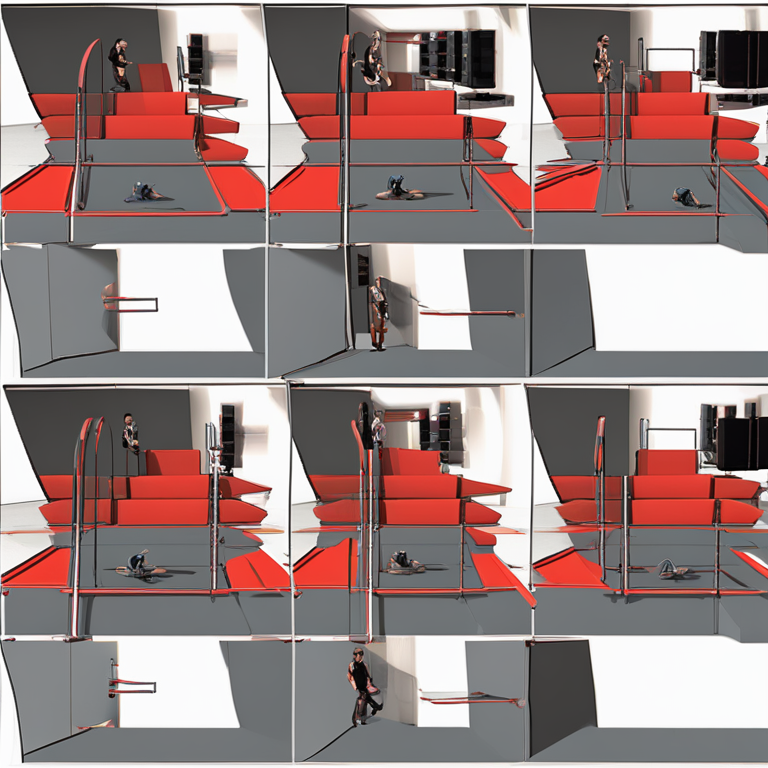← Back to Main
Simple Interaction-based Immersiveness
5/2/2024, 6:07:01 PM | Jeanyoon Choi

Original Notes (Pre-LLM)
When talking about immersiveness. Usually within AR/VR context… Usually talks about very precisely constructed beautiful 3D scenes, as well as very high-fidelity interactions… Usually focuses on mimicking the real, making simulacres.
Yet, what I propose: Immersiveness is not merely about reconstructing the real, being immersed in the hyper-real, it is more of embodies and interconnectedness (to the dimension of reality), which might trigger from well-reconstructed scene, but also inducable from very simple interaction and the cognitive connection towards it - What I actually see from numerous VR games and artworks is when very complicated interaction paradoxically make users detached to the scene, and thus disentangling from immersiveness. What I propose is the opposite → Really starting from a simple interaction, very simple and somehow dadaistic (via repetition) that anybody can easily understand, and emphasising it, throughout targeted multi-channels, to create single interaction-based immersiveness.
Example: Mouse movement. Mouse movement is already used as a way of rotating the scene’s angle within Web Games/Wb 3D. What if… The mouse cursor itself is emphasised across the space? So single mouse movement from a single channel is propagated to multiple channels simultaneously, somehow exaggerated, somehow repeated, so people feel somehow will-to-power to their mouse movements, as well as dadaistic enjoyment → Their simple mouse movement has created a significant audio-visual change across 20 different channels! Wouldn’t that be amazing? Wouldn’t that be truely immersive?
Example 2: Three.js OrbitControls → Rotation, Panning… How can this apply within multi channels?
English Version (LLM-Generated)
When considering the concept of immersiveness, we often lean towards understanding it within the contexts of Augmented Reality (AR) and Virtual Reality (VR). The general perception is that immersive experiences are synonymous with meticulously crafted and visually impressive 3D scenes. Furthermore, the element of high fidelity in interaction plays a significant role. For many, these immersive experiences concentrate heavily on replicating the real world to create perfect simulacra.
However, the idea I propose pivots from this traditional understanding of immersiveness. I envision immersiveness not just as a replica of the hyper-real or the real world, but rather, as a more profound sense of interconnectedness that binds the participant to the dimension of reality. This interconnectedness can stem from a well-reconstructed scene. However, it can also derive from a simple interaction that leads to a cognitive alignment or connection. This observation is substantiated by numerous VR games and artworks where complicated interactions paradoxically disengage users from the scene. Consequently, they are disconnected from the immersive experience.
What I propose instead is the antithesis - commence with a simple interaction that can be easily understood and executed by all. To further this, the interaction should be simple, yet portrayed as dadaistic using repetition as the tool. Subsequently, emphasis should be placed on this interaction while targeting the right multi-channels. This, I believe, will enable the creation of an immersive experience rooted in a single interaction.
For instance, consider the use of mouse movement. While this is already utilised to rotate a scene's angle in web games and 3D web spaces, what if we could bring emphasis to the mouse cursor across the space? What if a single mouse movement could be so highly exaggerated and repeated that it propagates across several channels simultaneously? This could then give the participant a sense of heightened control over the mouse movement and induce a sense of dadaistic enjoyment. Seeing their simple mouse movement generate significant audio-visual changes across multiple channels could prove to be a truly amazing and immersive experience.
This concept could be extended to scenarios such as the OrbitControls in Three.js. There are interesting avenues of exploration in how rotation and panning can be efficiently applied across multiple channels.
Korean Version (LLM-Generated)
흔히 몰입감에 대해 얘기할 때, 대개 AR/VR 컨텍스트 내에서 극도로 섬세하게 구축된 아름다운 3D 장면들이나, 높은 퀄리티의 인터랙션에 대해 말합니다. 주로 현실을 흉내내는 것에 초점을 맞추어, 가상현실을 재창조하는데 주력합니다.
그러나 제가 제안하는 것은, 몰입감이 현실을 재창조하는 것만큼 중요하진 않으며, 오히려 체화되고 상호 연결성을 갖는 것이 더 큰 중요성을 가집니다. 이는 잘 구축된 장면으로부터 시작되기도하지만, 간단한 인터랙션과 그에 대한 인지적 연결로 이끌어질 수도 있는 특성입니다. 제가 VR 게임과 예술작품에서 주로 본 것은, 복잡한 인터랙션이 사용자를 paradoxically 장면에서 분리시키고, 따라서 몰입감을 흐리는 것입니다. 제가 제안하는 것은 바로 반대입니다. - 매우 간단하고 반복적으로 누구나 쉽게 이해할 수 있는 인터랙션에서 시작하여, 그것을 강조하고, 타겟이 되는 다양한 채널들을 통해 단일 인터랙션 기반의 몰입감을 만드는 것입니다.
예를 들어, 마우스 움직임입니다. 마우스 움직임은 이미 웹 게임이나 3D 웹 상에서 장면의 각도를 회전시키는 방법으로 사용되고 있습니다. 그러면... 마우스 커서 자체가 공간 전반에 걸쳐 강조되면 어떨까요? 단일 채널의 단일 마우스 움직임이 동시에 여러 채널로 전파되어, 무언가 과장되고, 무언가 반복되어, 사용자는 마우스 움직임에 대한 의지를 느끼고 다다이스틱한 즐거움을 얻습니다. 그들의 간단한 마우스 움직임이 20여 개의 다른 채널에서 유의미한 비주얼 및 오디오 변화를 일으킨다면, 그것이야말로 놀랍지 않을까요? 그것이야말로 진정한 몰입감이라 할 수 있지 않을까요?
두번째 예로는 Three.js OrbitControls이 있습니다. -> 회전, 패닝... 이것은 어떻게 다중 채널에서 적용될 수 있을까요?
Tags
immersiveness
interaction
Ideation
simple
dadaistic
repetition
multi-channels
simple interaction
immersive
immersive experience
simple interaction-based immersiveness
simple interaction-based immersive experience
simple interaction-based immersive
simple interaction-based
simple interaction-based immersive experience
simple interaction-based immersive
simple interaction-based
simple interaction-based immersive experience
simple interaction-based immersive
simple interaction-based
simple interaction-based immersive experience
simple interaction-based immersive
simple interaction-based
simple interaction-based immersive experience
simple interaction-based immersive
simple interaction-based
simple interaction-based immersive experience
simple interaction-based immersive
simple interaction-based
simple interaction-based immersive experience
simple interaction-based immersive
simple interaction-based
simple interaction-based immersive experience
simple interaction-based immersive
simple interaction-based
simple interaction-based immersive experience
simple interaction-based immersive
simple interaction-based
simple interaction-based immersive experience
simple interaction-based immersive
simple interaction-based
Text written by Jeanyoon Choi
Ⓒ Jeanyoon Choi, 2024